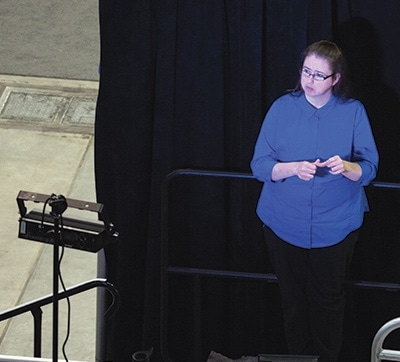
Adventist Review/ANN
Speaking through an interpreter, a young man in a private non-Christian vocational school for the deaf and blind in Lesotho, in southern Africa, stood up among the student assembly and told the visiting General Conference (GC) representative, “I want to learn about Jesus.”
He then shared his story of being turned away from a Sunday-keeping church because there was no one to interpret for him.
“His tears told me how much he wanted to know more about Jesus,” said Larry Evans, coordinator for GC Adventist Deaf Ministries International (ADMI), who was visiting the school. “The young man had heard about Jesus, but the church doors were closed to him. Is it any wonder that only 2 percent of the 250 million culturally Deaf in the world are Christian?”
Evans began creating an official identity for the Adventist Deaf soon after accepting the role of coordinator for Deaf Ministries in 2010. Regional Deaf ministry coordinators have since been put in place in each of the church’s 13 world divisions, and an international Web site was developed that offers resources for both the Deaf and the hearing who want to help the Deaf. The GC has also hired a Web content manager, Amanda Colgan, who is deaf and lives and works from her home in the Hyannis, Massachusetts, area of the United States.
“Amanda is very computer savvy; she’s tops,” Evans says. “The Deaf know and highly respect her. This helped to create a sense of network for the Deaf.”
The culturally Deaf have their own worldview and unique characteristics, including humor and language, Evans said, as well as 400 different sign languages—and they don’t usually live together in grouped populations.
“So how do we reach all of them?” Evans asked. Part of the answer, he said, is technology.
With a grant provided by Versacare, ADMI was able to purchase a partnership with Hope Channel. As a result, Hope Channel Deaf will launch November 1, 2015. Some 200 programs in five categories—Bible study and evangelism, health, children, and nature—will be aired and subtitled in five languages: Spanish, French, Portuguese, German, and English, with more to be added later.
“What we’re trying to create is not a program but a people movement,” Evans said. “That means people become excited about what’s happening and begin to share with other people. Ideas begin to flow in; resources are created; financial assistance becomes spontaneous, and momentum develops. We’re beginning to see some of that already.”
Even though GC session planners have previously used interpreters for the Deaf, this session is the first time the interpretations have been broadcast.
“The Deaf around the world can now know what is happening and being said at a GC session live, thanks to Hope Channel,” Evans said. “Deaf from Germany, Finland, Spain, and Brazil have already written to express their appreciation. They say they’re now feeling part of the Adventist Church.”
An ADMI booth is also set up in the exhibit hall—another first for GC Deaf Ministries.
“Whether a person is deaf or has other physical limitations, they too have abilities and talents, and we need to include them in our meetings and committees where we develop mission strategies,” Evans said. “We must make room for them ‘at the table.’ ”
To access resources or to find out more about Adventist Deaf Ministries International, go to www.adventistdeaf.org.